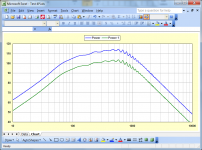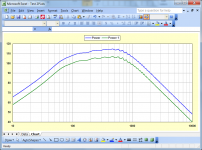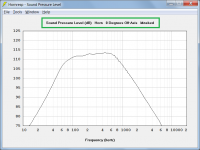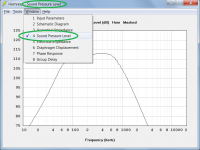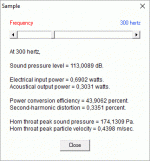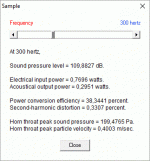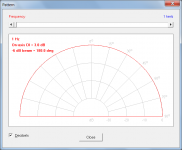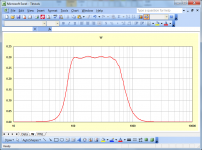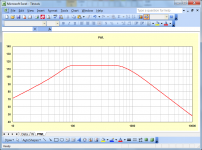But Hornresp references its "power" to radiation angle limit, while power does not. "Power" of Hornresp is not power but "pressure referenced to ratio of beam width to radiation angle limit".
Sounds like you need to simulate in free space condition and then export the impulse response for further post processing.
Simulate anything, at first with full sphere radiation, at second with half sphere one, and compare: At low frequencies "power" and pressure rise with 6dB, but power does with only 3dB. At high frequencies, at which the loudspeaker beams on its own, "power" rises by 3dB, while power does not at all.
Attachment 1 compares the power response referenced to 1 pW * (blue trace) to the Hornresp-calculated power response (green trace). The source is radiating into free space or 4 Pi steradians solid angle. The two curve traces are identical in shape, offset in this case by 10.83724 dB.
Attachment 2 compares the power response referenced to 1 pW * (blue trace) to the Hornresp-calculated power response (green trace). The source is radiating into half space or 2 Pi steradians solid angle. The two curve traces are identical in shape, offset in this case by 7.82694 dB.
The difference in offsets is 10.83724 - 7.82694 = 3.01030 dB = 10 * Log10(2) dB as expected from the theory.
As previously explained, the Hornresp-calculated power response is not referenced to 1 pW, so the absolute levels will always be different to those calculated using 1 pW. As demonstrated above however, the actual shape of the curves will always be identical.
I don't agree with the assertion that the only valid power response curve is one referenced to 1 pW.
~~~~~~~~~~~~~~~~~~~~~~~~~~~~~~~~
* NOTE - A modified version of Hornresp was used to calculate the power response referenced to 1 pW. It is not possible to use the production version of Hornresp to obtain these results because as already explained, the reference value is different.
Attachments
But Hornresp references its "power" to radiation angle limit, while power does not. "Power" of Hornresp is not power but "pressure referenced to ratio of beam width to radiation angle limit".
The curves are identical in shape. What is important to Hornresp users is how the curve changes with frequency, and the two curves in question have exactly the same variation across the frequency range. The reference value used in Hornresp allows users to directly compare Hornresp predictions against measured test results.
You consider that the only valid power curve is one referenced to 1 pW. I do not hold that view. The reference can be any power value, because given the reference value, the absolute power value can always be retrieved - no information is lost.
PWL = 10 * Log10(W / Wref) dB
Given PWL and Wref:
W = Wref * 10 ^ (PWL / 10) watts
"Power" of Hornresp is not power but "pressure referenced to ratio of beam width to radiation angle limit".
The Hornresp "Acoustical Power" chart plots power level (PWL) versus frequency.
PWL = 10 * Log10(W / Wref) dB
where Wref = Ang * (4 * 10 ^ -10) / (1.205 * 344) watts
Beam width is not a factor in calculating the Acoustical Power chart values.
Beam width is taken into account when the Directivity tool is used, and the "Acoustical Pressure" chart is plotted.
Beam width is not a factor in calculating the Acoustical Power chart values.
That is an important point, Uli. Radiated power is independent of beam width.
If having the power level expressed as dB re 1pW is a matter of life and death to you, why don't you simply export the Hornresp data, import it into Excel, and perform the conversion from from power re David's Wref to power re 1pW? David has given the required math further up in this thread. Then you can plot your "true" power level curve, with a chart title of your choice, without getting confused with the Hornresp chart title.
Not according to Hornresp. I halve radiation angle limit, and Hornresp tells me, that power had doubled at trebles, where in reality power does not rise, because beam width is less than radiation angle limit anyway.That is an important point, Uli. Radiated power is independent of beam width.
Dear David, would thou offset pressure level curve by a random amount, because "absolute values do not matter, all what matters is frequency response"? This is, what thou do with power, ignoring half of its meaning.
Not according to Hornresp. I halve radiation angle limit, and Hornresp tells me, that power had doubled at trebles, where in reality power does not rise, because beam width is less than radiation angle limit anyway.
As previously explained, the Acoustical Power chart is calculated when directivity characteristics (i.e. beam width) are unknown. A nondirectional acoustical power source radiating into the specified solid angle is assumed. When directivity characteristics are known, the Directivity tool can be used to calculate the Acoustical Pressure chart. This is exactly the same approach as taken by AkAbak.
Dear David, would thou offset pressure level curve by a random amount, because "absolute values do not matter, all what matters is frequency response"? This is, what thou do with power, ignoring half of its meaning.
Rather than generating an Acoustical Power chart when the acoustical power source is nondirectional and an Acoustical Pressure chart when the acoustical power source is directional, perhaps the following alternative approach might be more acceptable.
1. The "Acoustical Power (dB)" and "Acoustical Pressure (dB)" chart titles to both be renamed "Sound Pressure Level (dB)".
2. The default Sound Pressure Level chart to be calculated assuming a nondirectional source, with the acoustical power output producing the sound pressure radiating uniformly into the solid angle specified by the Ang input parameter.
3. The Directivity tool to be used to calculate the Sound Pressure Level chart taking directivity characteristics (i.e. beam width) into account.
Both charts would have the same "Sound Pressure Level (dB)" title, but one would also include off-axis angle information (when the Directivity tool is used) whereas the other (the default chart) would not. Hopefully this difference in captions would minimise the chances of any confusion as to what a particular chart represents. The Hornresp Help file would of course also be modified to document the difference.
Attachment 1 shows the default chart.
Attachment 2 shows the chart when the Directivity tool is used.
Attachment 3 shows the Window menu command.
I would appreciate user feedback on the "Sound Pressure Level" alternative approach.
Attachments
Last edited:
and what's with the 18th century language?
I can do better than that - see my 16th century quote from William Shakespeare in Post #6414 🙂.
Not according to Hornresp. I halve radiation angle limit, and Hornresp tells me, that power had doubled at trebles, where in reality power does not rise, because beam width is less than radiation angle limit anyway.
Uli, this is getting silly. Have you not read what David explains in post #6385, that the reference power changes with radiation angle? The Power Response (dB) chart is not the power level re 1pW. Therefore you cannot say that halving the radiation angle doubles the radiated power just because the curve rises with 3dB. Do yourself a favour and check the facts: if you want to check the actual power, use the sample tool.
To help you grasp this, I have done it for you. Attachment 1 shows the sample window for 1pi radiation angle, attachment 2 shows the sample window for 0.5pi radiation angle. As you can see, the radiated power is very nearly the same.
Further, as David has repeatedly explained (and as the help file also clearly explains), directivity is not taken into account in the default SPL calculation. The horn radiates with a constant beamwidth at all frequencies given by the radiation angle. (And this makes it possible to get the SPL response for multiple segment horns, which cannot use the directivity model, as David has also explained.) The frequency dependent beamwidth is not taken into account unless you use the directivity tool.
Attachments
What can be constructively explained with regards to Uli's comments has been accomplished.
Anyone who has raised children recognizes the type of arguement brought forth by Uli.
It reminds me of my two sons when they were 6 and 7 and informed me that they would scream at the top of their voices until I bought the item they requested in the store we were in.
I gave them two choices. They had my answer and it was not going to change. And they could choose to be quiet.
Yell all you want Uli. You have your answer. And it is not going to change.
Anyone who has raised children recognizes the type of arguement brought forth by Uli.
It reminds me of my two sons when they were 6 and 7 and informed me that they would scream at the top of their voices until I bought the item they requested in the store we were in.
I gave them two choices. They had my answer and it was not going to change. And they could choose to be quiet.
Yell all you want Uli. You have your answer. And it is not going to change.
David, having SPL as default rocking response seems reasonable. But it should not be its average over radiation angle limit but SPL on axis, as one would hear it standing in front of it in free field.
Hi Uli,
IMO absolutly not. To the best of my knowledge it's also not possible for some system configurations in Hornresp.
Aside from gain one of the benefits of horns is to optimize response and coverage over a given range off axis. You may want to further research into topics around what is ideal when it comes to loudspeaker system directivity for a given application.
What is your application for Hornresp BTW?
IMO absolutly not. To the best of my knowledge it's also not possible for some system configurations in Hornresp.
Aside from gain one of the benefits of horns is to optimize response and coverage over a given range off axis. You may want to further research into topics around what is ideal when it comes to loudspeaker system directivity for a given application.
What is your application for Hornresp BTW?
David, having SPL as default rocking response seems reasonable. But it should not be its average over radiation angle limit but SPL on axis, as one would hear it standing in front of it in free field.
To calculate on-axis SPL it is necessary to know the directivity characteristics. The default response is calculated when directivity characteristics are unknown. If directivity characteristics are known, the Directivity tool can be used and the on-axis SPL calculated. For 2 Pi space, the default chart in effect plots the SPL for the radiation pattern shown in the attachment below, with the condition that the pattern does not change with frequency. The SPL is the same at any angle.
The default nondirectional or so-called "power" response is useful in practice because the results provide a reasonably accurate indication of performance at lower frequencies, where directivity is not an issue.
It is important to recognise the difference between a "power" response, which can be normalised so that the results are equivalent to nondirectional SPL, as is done in Hornresp, and a "pressure" response, which shows SPL with directivity taken into account.
Attachments
O.k.. If directivity is not available after "calculate", then keep the function as used now but rename it "SPL at 1 meter distance, averaged over whole radiation space" or "nondirectional SPL", please. And provide to plot a true power function, please. At this time i plan no horn, but i used Hornresp to design several horns, lately a big fullrange and a smaller treble one. Twenty-five years ago i built a bass horn out of a wardrobe. That had punch. Unfortunately the Tonsil 12 inch driver was mounted asymmetrically in one side of an opening crack and started to rasp voice coil against magnet system after some use.
I´d prefer if you change your "language" to a more "making a pollite request" tone. Maybe it´s my education, but IMHO your "wishes" sound a little like orders (the "please" at the end of the sentences doesn't help much in this case).
O.k.. If directivity is not available after "calculate", then keep the function as used now but rename it "SPL at 1 meter distance, averaged over whole radiation space" or "nondirectional SPL", please.
I understand that you don't like the existing chart title and that you believe it to be wrong and misleading, but I prefer it to the other possible options discussed to date, and have decided once again, after further careful consideration, to leave it as it is. The Help file explains exactly how the results are calculated if anyone is in any doubt as to how they should be interpreted.
And provide to plot a true power function, please.
I am not exactly sure what you mean by true power function, but a plot of output watts versus frequency, or of the ratio in decibels of output watts to 1 picowatt versus frequency, would be of little practical value to Hornresp users.
If however output power versus frequency does indeed need to be plotted for some reason, then the existing chart data can be exported to a spreadsheet and the output power W calculated at each frequency using the following formula:
W = Ang * (4 * 10 ^ -10) / (1.205 * 344) * 10 ^ (SPL / 10) watts
Where Ang is the solid angle value specified in the simulation (e.g. 2 * Pi for half space radiation), and SPL is the value given in the SPL (dB) column of the spreadsheet.
If necessary, the Acoustical Power Level PWL referenced to 1 picowatt can be calculated using the following formula:
PWL = 10 * Log10(W / (10 ^ -12) ) dB
Where W is the output power calculated using the first equation.
Attachment 1 shows a plot of output watts vs frequency for the default Hornresp record with resonances masked.
Attachment 2 shows a plot of acoustical power level referenced to 1 picowatt vs frequency for the default Hornresp record with resonances masked.
Attachments
Never mind, David, it is thy program, and programs do not prick or shoot. Sabbelbacke, understood, if thou would just defend the truth.
I wasn't going to comment but this has gone on long enough. Grasso has not given any reason whatsoever for requesting the things he has (renaming the current Acoustical Power graph and adding another Power graph) other than defending "the truth".
If a poll were taken I'm sure 100 percent of people voting (minus Grasso) would vote to leave things as they are. The current Acoustical Power graph gives results very close to what you would measure if you actually built what you simulated, as has been proven countless times. The directivity tool goes the extra mile. It really doesn't matter what the Acoustical Power graph is named, it's pretty clear what the graph is showing and the Hornresp Help file explains what it is adequately. The proposed new Power graph is almost completely useless for the average person using this program.
It made me wonder what Grasso's motive actually is, since he hasn't given a reasonable reason for these requests. It took about 5 minutes to find out his actual motive by checking a few of his earlier posts.
This is the content of one of his first posts in his introduction thread on March 9, 2016.
http://www.diyaudio.com/forums/introductions/288185-hi-all.html#post4643678
It would seem that he has a lot of unconventional ideas and very much likes pushing them on people, by his own description.
As far as I'm concerned, Hornresp is one of my favorite tools, it is not "stinking brew", it is quite useful as it is, and the proposed changes would not help and could actually make it less useful. I'm almost always going to vote for more (and more correct) information, but in this case, the request for a semantic name change and an extra useless graph holds no value in my opinion.
A quick peek some of Grasso's other early posts shows that he interrupted a VERY long Synergy thread to simply point out that in his opinion Synergys are stupid. And the design routine that he prefers (a rip off of the military tech that led to the development of Keele's CBT array) shows that he doesn't even understand his preferred loudspeaker layout.
A quick scan of Grasso's early posts shows he's just here to "topple the drum" and disrupt the status quo. Taken in that context it becomes easier to give them the consideration they deserve.
FWIW I have a lot of unpopular ideas too and I'm quite outspoken at times when it comes to defending the truth, but at least I can always back up everything I post. To be honest, the spirit of the above quoted post sounds a lot like something I could write about myself (minus the spiritual adventure and losing it all and the D'Appollito globes), but it seems that Grasso's targets so far have been Hornresp and Synergy horns, two things which are quite undeserving of the negative attention he's given them.
If a poll were taken I'm sure 100 percent of people voting (minus Grasso) would vote to leave things as they are. The current Acoustical Power graph gives results very close to what you would measure if you actually built what you simulated, as has been proven countless times. The directivity tool goes the extra mile. It really doesn't matter what the Acoustical Power graph is named, it's pretty clear what the graph is showing and the Hornresp Help file explains what it is adequately. The proposed new Power graph is almost completely useless for the average person using this program.
It made me wonder what Grasso's motive actually is, since he hasn't given a reasonable reason for these requests. It took about 5 minutes to find out his actual motive by checking a few of his earlier posts.
This is the content of one of his first posts in his introduction thread on March 9, 2016.
i have been tinkering with loudspeakers since i was twelve. Three years later i built a pair of three-way floor-standing speakers, of my own but very conventional design, to find out, that many conventions are wrong. Another three years later i built true D'Appollito two-way globe speakers (the casting mold for the plaster was one half of an illuminated globe) to ascertain myself, that beamwidth and nonlinear distortions are important. I then slowed down my HiFi efforts, because the HiFi buisness is too dishonest. Still later i got a music rehersal room with a small electro-acoustical workshop, doing mostly louder stuff but still quite experimental. It was a shocking year, when i lost it all for my love of truth and creativity (writing internet stuff which is against political interests too powerful). After an adventure into the spiritual world (changing minds IS difficult), i am back at the HiFi thing, because this is the best, which i can do now. There are far too many people living on this planet, and most people are far too dishonest. SNAFU, but i am searching for an atlas to use my lever on, topple the drum and spill the stinking brew on the floor.
http://www.diyaudio.com/forums/introductions/288185-hi-all.html#post4643678
It would seem that he has a lot of unconventional ideas and very much likes pushing them on people, by his own description.
As far as I'm concerned, Hornresp is one of my favorite tools, it is not "stinking brew", it is quite useful as it is, and the proposed changes would not help and could actually make it less useful. I'm almost always going to vote for more (and more correct) information, but in this case, the request for a semantic name change and an extra useless graph holds no value in my opinion.
A quick peek some of Grasso's other early posts shows that he interrupted a VERY long Synergy thread to simply point out that in his opinion Synergys are stupid. And the design routine that he prefers (a rip off of the military tech that led to the development of Keele's CBT array) shows that he doesn't even understand his preferred loudspeaker layout.
A quick scan of Grasso's early posts shows he's just here to "topple the drum" and disrupt the status quo. Taken in that context it becomes easier to give them the consideration they deserve.
FWIW I have a lot of unpopular ideas too and I'm quite outspoken at times when it comes to defending the truth, but at least I can always back up everything I post. To be honest, the spirit of the above quoted post sounds a lot like something I could write about myself (minus the spiritual adventure and losing it all and the D'Appollito globes), but it seems that Grasso's targets so far have been Hornresp and Synergy horns, two things which are quite undeserving of the negative attention he's given them.
Last edited:
- Home
- Loudspeakers
- Subwoofers
- Hornresp
